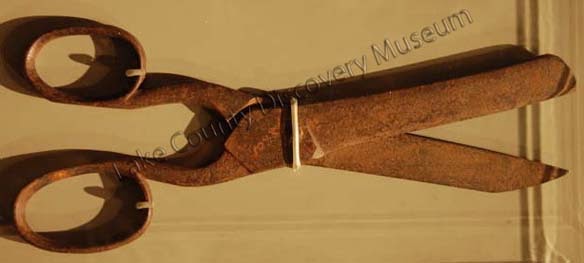Among the oldest items in the museum's archival collections is a diary kept by Hannah Gwinn Loring (1791 - 1847) written between 1804 - 1807. Hannah kept the diary when she was living in her hometown of Salem, Massachusetts with her parents, Thaddeus Gwinn and Mercy Bradlee Gwinn.
Although the fragile pages of the diary have not been transcribed, we know that it was first required as a school exercise when Hannah was twelve years old, and later she continued to write in it voluntarily. The diary covers every day matters, especially focusing on community gatherings and church meetings.
One of the first entries in Hannah Gwinn's 1804 diary:
"I am again assembled with my young mates
and hope to pass my time agreeably."
Dunn Museum 93.45.349
|
In September 1807, Hannah wrote: "I left school with regret. My parents think it is time for me to commence assisting in domestic affairs for they think it very essential for a female to be well skilled in all the active comings of life."
Within two years, Hannah found a suitor in Samuel Loring, a ship's captain in Salem's profitable commercial shipping trade. As it turned out, Samuel was a bit of a romantic.
Samuel Loring (1785 - 1843). This carte-de-visite
photo was made from a painting of Loring.
Dunn Museum 93.45.349.5
|
On Christmas Day, December 25, 1809 Samuel wrote a poem to Hannah while "on Board the Jennifer at sea near Bermuda" over 700 miles away.
Good night good night and is it so
and must I from my Hannah go
Oh Hannah say good night once more
And I'll repeat it o'er & o'er
Till the first glance of Dawning light
Shall find us still saying good night
And still good night my Hannah say
But whisper still a minutes stay
and I will stay & every minute
Shall have an age of Rapture in it
xxx talk & speak in quick Delight
And murmur while we kiss good night
Good night you murmur with a sigh
And tell me it is time to fly
And I will now to kiss no more
Yet kiss you closer than before
xxxxxx
And then Dear Girl once more good night
Samuel Loring's poem to his sweetheart Hannah Gwinn.
Composed December 25, 1809. Dunn Museum 93.45.349.4
|
Hannah and Samuel married two years later on Christmas Day, 1811. At the time, Christmas was not celebrated as it is today, and the families that did make note of it simply went to church or shared a special meal together. Hannah's marriage to Samuel made this a Christmas to remember.
The Lorings had six children: Samuel, Jr., Spencer, Mercy, Frank, Thaddeus and William.
In 1819, Samuel Loring took Hannah's diary with him to sea. He used the blank pages at the back of the diary for his ship master's log from December 28, 1819 - August 30, 1820. The log's entries detail his travels from his home port of Salem, Massachusetts to Baltimore, Superior, the West Indies, Curocoa (island in Carribean), and St. Lucia.
I like to believe that Samuel didn't take Hannah's diary just for the use of its blank pages, but wanted a sweet reminder of his wife while they were separated for weeks at a time.
Tragically, in 1843, Samuel Loring died at sea. The loss meant that Hannah would never see her beloved Samuel again, since his body was buried at sea.
Hannah and Samuel's only daughter, Mercy, invited her widowed mother to come live with her. Mercy Loring had married George E. Smith a pianoforte maker (from a long line of mariners and cabinet makers in Salem). The young couple had settled in Millburn, Lake County, Illinois with their two-year old daughter Susannah. ("Susie" married David J. Minto in 1869).
Hannah Loring made the long trek to Illinois to live with her daughter's family, bringing her childhood diary/Samuel's ship's log, and poems.
On September 18, 1847, Hannah passed away with her daughter and grandchildren around her. She is buried at Home Oaks Cemetery on Deep Lake Road in Lake Villa.
Grave marker for George Smith and Mercy Loring Smith's
mothers who lived with them in Millburn:
Hannah Gwinn Loring and Mary Ford Smith. |
The few mementos that Hannah brought with her from Salem were treasured by her descendants, who spent long hours re-reading Hannah's diary and Samuel's ship's log.
In 1993, Hannah's great-great granddaughters, Lura Johaningsmeir and Katherine Minto, donated these items, along with other Smith and Minto family heirlooms to the Bess Bower Dunn Museum of Lake County (formerly the Lake County Discovery Museum).
D. Dretske, Curator ddretske@lcfpd.org








































